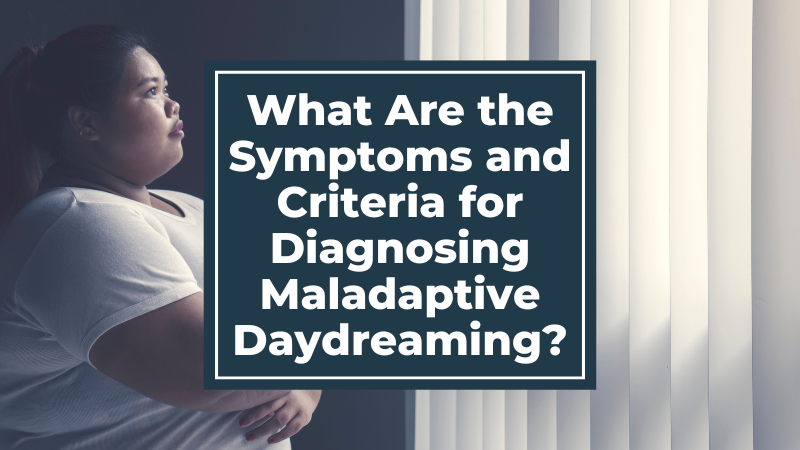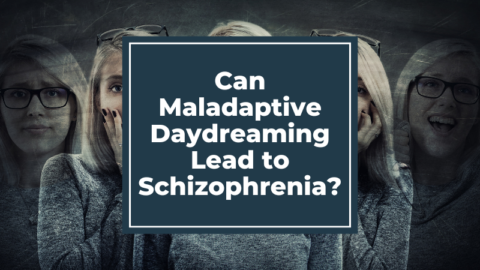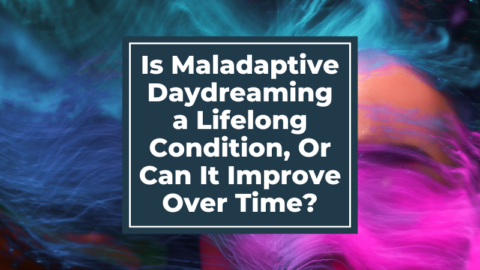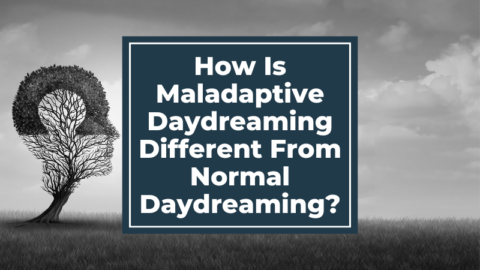Maladaptive daydreaming is not currently recognized as a formal psychiatric disorder in diagnostic manuals such as the Diagnostic and Statistical Manual of Mental Disorders (DSM-5). However, researchers have proposed some criteria and symptoms that may indicate the presence of maladaptive daydreaming. It’s important to note that these criteria are not definitive and may vary among individuals.
Here are some common symptoms and criteria associated with maladaptive daydreaming:
Symptoms and Criteria for Diagnosing Maladaptive Daydreaming
1. Excessive Daydreaming
Excessive daydreaming is a key sign or symptom of maladaptive daydreaming. Individuals with maladaptive daydreaming often engage in vivid and elaborate daydreams that are difficult to control. These daydreams may be triggered by internal thoughts, external stimuli, or specific environmental conditions.
Unlike typical daydreaming, which is a normal and healthy part of imagination and mental processes, maladaptive daydreaming involves an intense and compulsive need to daydream excessively. Individuals with maladaptive daydreaming often find it difficult to control or limit their daydreaming episodes, leading to a significant amount of time being spent in vivid and elaborate daydreams.
It’s important to note that excessive daydreaming alone may not indicate maladaptive daydreaming, as it can be influenced by various factors. A diagnosis of maladaptive daydreaming requires the presence of other specific criteria, such as distress or impairment caused by daydreaming, the compulsion to daydream, and the inability to control or limit daydreaming episodes.
2. Time-Consuming
Maladaptive daydreaming is characterized by excessive time spent on daydreaming, often resulting in significant interference with daily activities, work, school, or relationships.
The amount of time spent daydreaming alone is not the sole determining factor for diagnosing maladaptive daydreaming. While there is no specific time limit or threshold that defines maladaptive daydreaming (some people have suggested a lower threshold as low as two hours others have suggested at least 6-8 as a requirement), it is generally characterized by excessive and compulsive daydreaming that significantly interferes with daily functioning, relationships, and overall well-being.
Individuals with maladaptive daydreaming may find themselves spending several hours each day engaged in daydreaming, often to the point where it becomes a dominant activity in their lives. However, it’s important to consider the impact of daydreaming on one’s ability to meet responsibilities, maintain relationships, and engage in real-life activities.
The key factor is the extent to which daydreaming becomes problematic and impairs daily functioning. If daydreaming consumes a significant amount of time, leads to neglect of essential tasks and responsibilities, causes distress, and interferes with relationships or other important areas of life, it may be indicative of maladaptive daydreaming.
8. Content and Themes
The content of daydreams in maladaptive daydreaming can vary widely among individuals. Some may have elaborate storylines, fictional characters, or idealized scenarios. Others may engage in repetitive or repetitive themes that provide comfort or escape from reality.
Common themes among maladaptive daydreamers can vary widely as they are highly individualized and personal. However, there are some recurring themes that are often reported by individuals with maladaptive daydreaming. These themes may serve as the basis for their daydreaming narratives and play a significant role in their immersive experiences. Some common themes include:
- Fantasy Worlds: Many maladaptive daydreamers create intricate and elaborate fantasy worlds or fictional scenarios in their daydreams. These worlds may involve characters, settings, and storylines that are rich in detail and complexity.
- Idealized Versions of Self: Maladaptive daydreamers often envision themselves as idealized versions of who they aspire to be. They may imagine themselves as successful, confident, or accomplished individuals, living out fantasies of achieving their goals or fulfilling their desires.
- Relationships and Interactions: Daydreaming about interpersonal relationships and interactions is another common theme. Maladaptive daydreamers may create imaginary relationships with fictional characters or idealized versions of real people, exploring emotional connections, friendships, or romantic encounters.
- Adventure and Excitement: Many maladaptive daydreamers incorporate elements of adventure, excitement, and thrill into their daydreams. They may envision themselves as protagonists in thrilling scenarios, such as epic quests, heroic adventures, or daring escapades.
- Emotional Catharsis: Daydreaming often serves as a means of emotional regulation and catharsis for maladaptive daydreamers. They may use daydreaming as a way to process and cope with difficult emotions, past traumas, or unmet psychological needs.
It’s important to remember that these themes can vary significantly from person to person, and individuals may have their own unique and individualized daydreaming experiences and themes. The themes in maladaptive daydreaming are deeply personal and often reflect the inner desires, fantasies, and emotional landscapes of the individual.
3. Difficulty Controlling Daydreaming
Difficulty controlling daydreaming is a characteristic feature of maladaptive daydreaming. Unlike typical daydreaming, which is a normal and fleeting activity, maladaptive daydreaming involves an excessive and uncontrollable engagement in daydreams that significantly interferes with daily functioning and responsibilities. The inability to control or stop daydreaming when desired is a key indicator that the daydreaming behavior has become maladaptive.
Maladaptive daydreamers often find themselves deeply absorbed in vivid and immersive daydreams for extended periods, sometimes for hours at a time. They may experience a loss of awareness of their surroundings, neglect important tasks or responsibilities, and have difficulty focusing on real-life activities. Despite attempts to resist or reduce the intensity of daydreaming, they struggle to exert control over their thoughts and find it challenging to redirect their attention back to reality.
This lack of control is a distinguishing factor between maladaptive daydreaming and ordinary daydreaming. While daydreaming can be a normal and enjoyable activity that occurs spontaneously and is easily modulated, maladaptive daydreaming involves a compulsive and persistent engagement in daydreams that disrupts one’s ability to function effectively in daily life.
The difficulty in controlling daydreaming is often a source of distress for individuals with maladaptive daydreaming, as they may feel trapped in their internal world and disconnected from reality. It is this impaired control over daydreaming that indicates the presence of maladaptive daydreaming as a distinct phenomenon.
4. Distress or Impairment
Maladaptive daydreaming can cause significant distress, impairment in functioning, or disruption in various areas of life, including social relationships, academic or occupational performance, and emotional well-being.
Firstly, the excessive and intense daydreaming episodes can consume a significant amount of time and mental energy, leading to neglect of important tasks, responsibilities, and social interactions. This neglect can result in academic or occupational problems, relationship difficulties, and a general sense of falling behind in life.
The immersive nature of maladaptive daydreaming can also lead to a disconnection from reality. Individuals may struggle to stay present in the moment or engage fully in real-life experiences, as their minds are preoccupied with elaborate daydreams. This disconnection can hinder their ability to form and maintain meaningful relationships, meet personal goals, and participate in activities that are important for personal growth and well-being.
Additionally, maladaptive daydreaming can cause emotional distress. Individuals may experience feelings of guilt, shame, or frustration due to their inability to control or stop the excessive daydreaming. They may recognize that their daydreams are unrealistic or interfere with their daily functioning, which can create a sense of dissatisfaction or disappointment in themselves.
5. Escape or Emotional Regulation
Daydreaming episodes in maladaptive daydreaming may serve as a means of escaping from reality or regulating emotions. Individuals may use daydreaming as a coping mechanism to cope with stress, anxiety, boredom, or other emotional states.
Using daydreaming as a form of escape or emotional regulation can be a sign of maladaptive daydreaming when it becomes excessive and interferes with daily functioning. Maladaptive daydreaming involves an intense reliance on daydreams as a means of escaping from reality or regulating emotions in an unhealthy or unproductive way.
Maladaptive daydreamers may find themselves excessively daydreaming to avoid dealing with unpleasant emotions, stressful situations, or real-life challenges. They may use daydreaming as a coping mechanism to escape from emotional pain, boredom, loneliness, or anxiety. Instead of facing and addressing these emotions directly, they retreat into elaborate and vivid daydreams as a way to temporarily detach from reality and experience a sense of control, excitement, or fulfillment.
The reliance on daydreaming as a primary coping strategy can be problematic when it hinders the individual’s ability to effectively manage and address their emotions in more adaptive ways. It may prevent them from developing healthy coping mechanisms, seeking support from others, or actively engaging in problem-solving strategies.
Furthermore, using daydreaming as a form of escape or emotional regulation can perpetuate a cycle of avoidance and withdrawal from real-life experiences and responsibilities. It can interfere with personal growth, hinder the development of important life skills, and limit the individual’s ability to effectively navigate and cope with challenges and setbacks.
While daydreaming can offer temporary relief or distraction, the excessive and uncontrollable use of daydreaming as a primary emotional regulation strategy can indicate maladaptive daydreaming. It is important for individuals who find themselves relying heavily on daydreaming for emotional regulation to seek support and explore healthier coping mechanisms to manage their emotions and engage more fully in real-life experiences.
6. Intensity and Absorption
Maladaptive daydreaming often involves a high level of intensity and absorption in the daydreaming experience. Individuals may become deeply engrossed in their daydreams, losing track of time and their surroundings.
In maladaptive daydreaming, the intensity and absorption of daydreaming experiences are often heightened compared to regular daydreaming. While daydreaming is a normal and common activity that many people engage in, maladaptive daydreaming involves a level of intensity and absorption that goes beyond typical daydreaming experiences.
In maladaptive daydreaming, individuals may become deeply engrossed and immersed in their daydreams, to the point where they may lose track of time, surroundings, and even their own sense of self. The daydreams are often vivid, detailed, and complex, creating a rich and immersive mental world that can feel more real and compelling than the external reality.
The intensity of the daydreaming experience in maladaptive daydreaming can be so strong that it becomes difficult to control or stop the daydreaming episodes. Individuals may find themselves spending excessive amounts of time daydreaming, sometimes for hours on end, leading to significant disruptions in their daily lives and responsibilities. This heightened intensity and prolonged engagement in daydreaming distinguish maladaptive daydreaming from regular daydreaming.
In contrast, regular daydreaming tends to be more fleeting, less absorbing, and easily controllable. It is often a brief and occasional mental diversion that occurs during idle moments or as a form of creative thinking or problem-solving. Regular daydreaming does not typically interfere with daily functioning or cause distress or impairment in a person’s life.
7. Compulsive Nature
Maladaptive daydreaming is characterized by a compulsive nature, which means that individuals experience an irresistible urge or strong compulsion to engage in excessive daydreaming. This compulsion often leads to a loss of control over the daydreaming episodes and difficulty in stopping or interrupting them.
Individuals with maladaptive daydreaming may find themselves compelled to enter their daydreaming world repeatedly, even when they try to resist or control it. The urge to daydream becomes a repetitive and ingrained pattern of behavior that is difficult to break free from.
The compulsive nature of maladaptive daydreaming is often driven by a variety of factors, including a desire for escapism, emotional regulation, or a need to cope with boredom, stress, or unfulfilled desires. Daydreaming provides an immersive and pleasurable experience that offers an escape from reality or a way to satisfy unmet psychological needs.
The compulsive nature of maladaptive daydreaming can lead to significant time and energy devoted to daydreaming, often at the expense of other important activities, responsibilities, and relationships. It can interfere with academic or work performance, social interactions, and overall functioning.
9. Emotional Involvement
Emotional involvement in maladaptive daydreaming refers to the intense and deeply felt emotions experienced during the daydreaming episodes. Unlike regular daydreaming, where emotions may be more fleeting or less intense, maladaptive daydreamers often report a heightened emotional connection to their daydreams.
Maladaptive daydreaming can evoke a range of emotions, including happiness, excitement, joy, sadness, fear, anger, or even a sense of fulfillment. The emotional involvement is often intense and immersive, leading to a strong emotional attachment to the daydreams and the characters or scenarios within them.
Emotions experienced during maladaptive daydreaming can be so compelling that they may impact a person’s real-life emotions and mood. The emotional intensity and involvement can provide a form of emotional escape or fulfillment, allowing individuals to experience a heightened sense of satisfaction or connection that may be lacking in their daily lives.
However, the emotional involvement in maladaptive daydreaming can also contribute to distress and impairment. The vivid emotions experienced during daydreaming can sometimes make it difficult for individuals to differentiate between the daydreaming world and reality, leading to a blurring of boundaries and potential difficulties in managing real-life emotions and relationships.
Overall, the emotional involvement in maladaptive daydreaming plays a significant role in the allure and allure of the daydreaming experience. It provides a way for individuals to experience intense emotions and gratification, but it can also contribute to the challenges and negative consequences associated with maladaptive daydreaming when it begins to interfere with daily functioning and well-being.
What To Do If You Think You Have Maladaptive Daydreaming?
While the symptoms and criteria mentioned earlier provide a general understanding of maladaptive daydreaming, it’s important to remember that individual experiences can vary. Some people may have additional or slightly different symptoms that are specific to their personal situation. It’s also worth noting that maladaptive daydreaming can co-occur with other mental health conditions such as anxiety, depression, or obsessive-compulsive disorder.
If you or someone you know is experiencing symptoms of maladaptive daydreaming or any other mental health concerns, it’s recommended to seek professional help from a mental health professional. They can provide a comprehensive evaluation, diagnosis, and appropriate treatment options tailored to the individual’s needs. Remember, seeking support is an important step toward managing and improving mental well-being.
It’s important to note that research on maladaptive daydreaming is still in its early stages, and there is an ongoing debate about its classification and diagnostic criteria. While the term “maladaptive daydreaming” has gained popularity, it is not officially recognized as a formal diagnosis. As our understanding of this phenomenon continues to evolve, further research may provide more insights into its features and potential treatment approaches.









